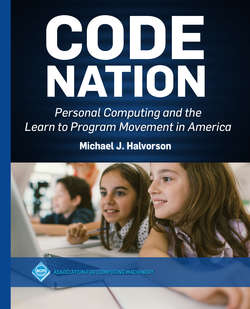Читать книгу Code Nation - Michael J. Halvorson - Страница 6
На сайте Литреса книга снята с продажи.
Contents
ОглавлениеAcknowledgments
PART ILEARNING TO CODE
Chapter 1How Important is Programming?
1.1Programming Culture
1.2Learning a Language
1.3New Ways of Thinking
1.4Equity and Access
1.5Personal Connections
1.6Manifestos of the Movement
1.7A New History of Personal Computing
Chapter 2Four Computing Mythologies
2.1The NATO Conference on Software Engineering
2.2The Complexity of Software
2.3Systems are for Customers
2.4The Counterculture Movement
2.5Everything is Deeply Intertwingled
2.6The Birth of Computer Science
2.7Computers for the People
2.8Personal Computing
Chapter 3FORTRAN, Logo, and the Tower of Babel
3.1Solving Problems with Computers
3.2The Tower of Babel
3.3High-level Languages
3.4Learning FORTRAN
3.5Daniel McCracken’s Primers
3.6Seymour Papert and Logo
3.7Cynthia Solomon
3.8Logo as a Model for Code Nation
3.9How successful was Logo?
Chapter 4Advocating Computer Literacy
4.1Robert Albrecht and the Popularization of the Movement
4.2I Speak BASIC
4.3The B. F. Skinner Approach
4.4Hold Me Closer Tiny BASIC
4.5Arthur Luehrmann and the Computer Literacy Debate
4.6A Blow to the Movement
4.7Apple Computer’s Education Agenda
4.8Applications over Languages
Chapter 5Four Million BASIC Programmers
5.1Introducing David Ahl
5.2A Proliferation of BASICs
5.3IBM BASICA
5.4Adventure Games
5.5Structured Programming
5.6Microsoft Press and Learn BASIC Now
5.7Microsoft Game Shop
5.8Visual Basic for Windows
5.9Innovative Programming Primers
PART IIHOBBYIST AND HACKER CULTURES
Chapter 6Power Users, Tinkerers, and Gurus
6.1Computing Terminology
6.2Tinkering with Personal Computers
6.3Van Wolverton and Batch Files
6.4The DOS for Dummies Phenomenon
6.5The Economic Impact of Personal Computers
6.6Cary Lu Introduces the Macintosh
6.7The Waite Group’s Macintosh Primers
6.8The Maturing Mac Platform
Chapter 7Hackers and Cyberpunks
7.1Bill Landreth and 1980s Hacker Culture
7.2Jude Milhon: From Civil Rights Activist to Cyberpunk
7.3Mondo 2000 and The Cyberpunk Handbook
7.4Cypherpunks and Cryptography
Chapter 8Computer Magazines and Historical Research
8.1Magazines and a Popular Culture of Computing
8.2Letters from the Programming Community
8.3New PC Users
8.4Power Users
8.5Advanced Hobbyists
8.6Professional Programmers
8.7New Approaches to Historical Research
PART IIIPROFESSIONAL PROGRAMMING CULTURES
Chapter 9Developing for MS-DOS: Authors and Entrepreneurs
9.1New Platforms for Commercial Software
9.2Inside the IBM PC with Peter Norton
9.3Borland’s Turbo Pascal
9.4Ray Duncan’s Advanced MS-DOS
9.5The MS-DOS Encyclopedia
9.6MS-DOS Sample Code
9.7Technology Diffusion
Chapter 10C Programming Nation: From Tiny C to Microsoft Windows
10.1The C Language
10.2Learning C on Personal Computers
10.3Academic and Professional Resources
10.4C Programming for the People
10.5Charles Petzold’s Programming Windows
10.6On Complexity
Chapter 11“Evangelism is sales done right”: PCs and Commercial Programming Culture
11.1The Macintosh Way
11.2The West Coast Computer Faire
11.3COMDEX and the Trade Show Movement
11.4The Trouble with Self-taught Programmers
11.5Software Engineering for the People
11.6Professional and Enterprise Development Systems
11.7Commercialization
Afterword: Programming in the Internet Age
Author’s Biography
Index
